Explore Pretoria - South Africa Travel, Africa
Welcome to Pretoria, South Africa's dynamic capital city! Known for its rich history and vibrant cultural scene, Pretoria offers an exceptional blend of tradition and modernity. As one of South Africa's three major metropolitants, it serves as the administrative hub of the country, making it a focal point for political and historical exploration. Whether you're drawn by its impressive historical landmarks, lush green spaces, or unique local cuisine, Pretoria promises an unforgettable experience.
Population: Approximately 2.8 million in 2023.
Economy: Pretoria's economy runs on key sectors including government, education, manufacturing, and services. The city is a hub for business and government activities, contributing significantly to South Africa’s economy.
Landmarks: Famous for the Union Buildings, Voortrekker Monument, and Pretoria National Botanical Garden.
South Africa
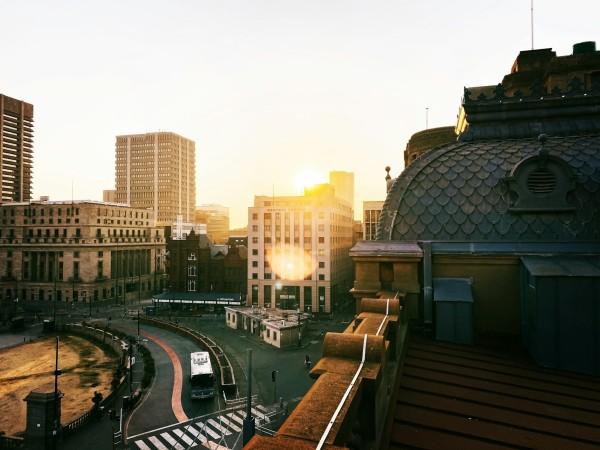
Overview of Pretoria
History & Cultural Influence
Founded in 1855 by Marthinus Pretorius, the city was named after him and quickly became a significant center during the South African War. The city played a pivotal role in the establishment of the Union of South Africa in 1910. Today, its historical landmarks, such as the Union Buildings and the Voortrekker Monument, stand as testament to its rich past. Furthermore, Pretoria's culture is diversified, reflecting the many influences that have molded it over time. The city boasts a blend of Afrikaner, British, and indigenous cultures, which is evident in its architecture, festivals, and daily life. The city's cultural heritage is celebrated in its numerous museums and galleries, offering a glimpse into its multifaceted history.
Interaction with The Locals
Pretoria, with a population of over 2.8 million people, is a thriving metropolis in South Africa's Gauteng region. The population is diverse, including a mix of Afrikaners, English-speaking South Africans, and various cultural communities. This diversity of origins contributes to the city's dynamic and cosmopolitan ambiance, which reflects a complex tapestry of traditions and contemporary influences.
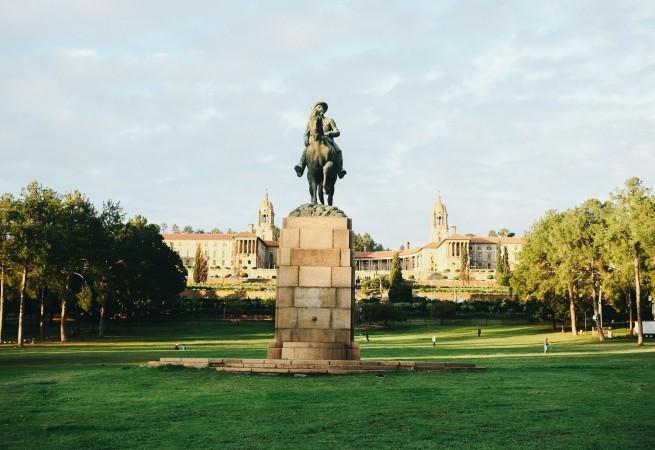
A statue of Louis Botha at the Union Buildings - © Sipho Ndebele
Top Attractions in Pretoria
Pretoria is rich in cultural and historical landmarks, offering a variety of attractions for visitors. Each of these must-visit attractions offer a rich tapestry of Pretoria’s cultural, historical, and natural heritage, making them essential stops for anyone exploring the city.
Union Buildings
The Union Buildings are an iconic symbol of South Africa’s history and politics. Designed by Sir Herbert Baker, these grand buildings serve as the seat of the South African government and the official residence of the President. Visitors may tour the stunning gardens, which provide panoramic views of Pretoria, as well as visit Nelson Mandela's monument, which commemorates his role in the country's history.
Voortrekker Monument
The Voortrekker Monument is a striking architectural landmark dedicated to the pioneers who embarked on the Great Trek. This imposing granite structure features intricate bas-reliefs and a museum that delves into the history of the Boer settlers. The monument's surrounding park offers scenic views and walking trails, making it a significant historical and cultural site.
Pretoria National Botanical Garden
The Pretoria National Botanical Garden is a serene oasis showcasing South Africa’s diverse plant life. Spanning over 80 hectares, the garden features a wide variety of indigenous flora, including the stunning Cycad Garden and a large collection of succulents. Visitors can enjoy leisurely walks along the well-maintained trails, picnic spots, and a café that overlooks the garden’s picturesque landscapes.
The National Zoological Gardens
The National Zoological Gardens is one of South Africa's largest and most diverse zoos. It houses a wide variety of animals, including rare and endangered species. The zoo is known for its conservation efforts and educational programs, providing visitors with the chance to learn about wildlife while enjoying well-designed enclosures and habitats.
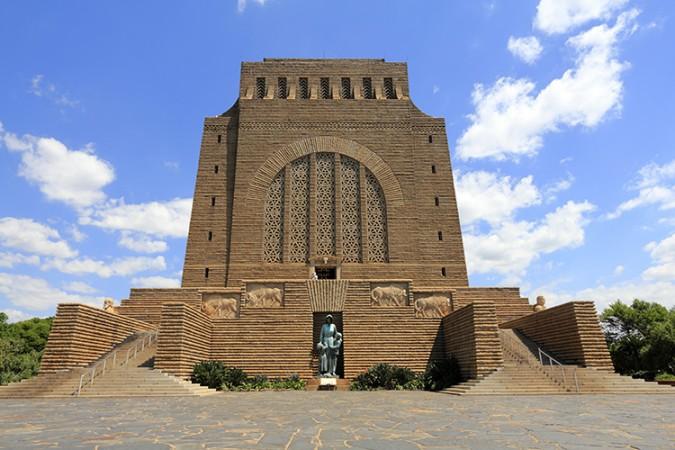
Voortrekker Monument - © History Hit
Must-Try Dishes in Pretoria
Pretoria's culinary tradition is rich with flavors and diverse influences, offering a variety of local dishes that capture the essence of South African cuisine.
- Bobotie: A flavorful minced pork dish with curry, a custard-like topping and a mixture of sweet and savory ingredients. This classic South African dish is typically served with yellow rice and chutney.
- Biltong: This dried, cured meat, typically made from beef or game, is seasoned with spices and offers a flavorful, chewy snack that’s a staple throughout South Africa.
- Bunny Chow: Bunny chow, a unique street snack from Durban, consists of a hollowed-out loaf of bread filled with hot curry. It’s a hearty and flavorful dish popular in Pretoria’s vibrant food scene.
- Sosaties: Skewered and grilled meat, frequently marinated with spices and herbs. Sosaties are a famous South African barbecue meal with a delicious, smokey taste.
- Potjiekos: A traditional South African stew cooked in a cast-iron pot over an open flame. This slow-cooked dish is typically made with meat, vegetables, and a rich blend of spices, resulting in a hearty and comforting meal.
- Pap and Chakalaka: Pap is a staple South African dish made from maize meal, often served with chakalaka, a spicy vegetable relish. The combination offers a flavorful, filling meal that’s both versatile and satisfying.
- Cape Malay Curry: A fragrant and mildly spiced curry, influenced by Cape Malay cuisine. It often includes ingredients like raisins, almonds, and a blend of spices, providing a unique taste experience.
- Vetkoek: Deep-fried bread dough, often enjoyed with savory fillings like minced meat or sweet toppings like honey. Vetkoek is a popular snack or meal option that offers a comforting, crispy treat.

Bunny Chow - © Bellbird Bakery
Festivals & Local Celebrations
These festivals and celebrations provide a rich tapestry of experiences, allowing visitors to immerse themselves in Pretoria’s cultural vibrancy and communal spirit. Whether you’re attending an agricultural show, enjoying the jacaranda blossoms, or participating in cultural festivities, Pretoria offers a range of events that showcase the city’s diverse heritage and lively atmosphere.
Pretoria Show
Held annually at the Pretoria Showgrounds, this event is one of South Africa’s largest agricultural shows. The Pretoria Show features a diverse range of attractions, including livestock exhibitions, agricultural displays, and live entertainment. Visitors can enjoy food stalls, craft markets, and family-friendly activities, making it a comprehensive showcase of rural life and culture.
Jacaranda Festival
The Jacaranda Festival takes place in October, when Pretoria's jacaranda trees are in full bloom, and transforms the city into a bright sea of purple. The festival includes street parades, music performances, and art exhibitions, celebrating the beauty of the jacaranda blossoms and the arrival of spring. It’s a perfect time to explore the city’s parks and enjoy outdoor events.
The South African Tattoo
Although not exclusively a Pretoria event, this annual military and cultural festival held at the Union Buildings is a highlight of the city's cultural calendar. The South African Tattoo features a spectacular display of music, dance, and military precision, bringing together performers from around the world. The event offers a unique opportunity to experience a blend of traditional and contemporary performances in a stunning historical setting.
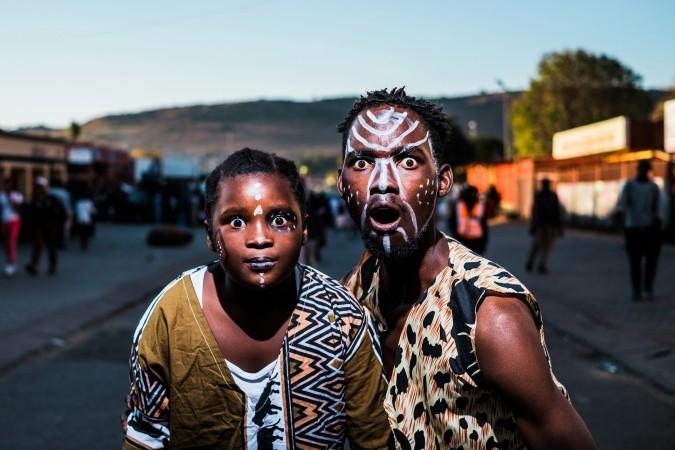
The South African Tattoo - © Mpumelelo Macu
What to Do in Pretoria
- Hiking Groenkloof Nature Reserve: Explore the natural beauty of Pretoria with hiking trails in places like the Groenkloof Nature Reserve and the Pretoria National Botanical Garden. These trails offer stunning views and opportunities to connect with nature.
- Wildlife Safaris in Rietvlei Nature Reserve: Nearby game reserves, such as the Rietvlei Nature Reserve, provide opportunities for wildlife viewing. Experience South Africa's rich biodiversity and enjoy guided safari tours.
- Exploring Parks and Gardens: Pretoria’s numerous parks and botanical gardens provide ideal settings for outdoor enthusiasts. Enjoy picnicking, jogging, or simply relaxing amid lush landscapes. The National Botanical Garden and the tranquil Groenkloof Nature Reserve are perfect for leisurely walks and nature observation.
- Museum Tours around Pretoria: Dive into South Africa’s rich heritage with visits to local museums. Explore the Ditsong National Museum of Natural History for its impressive fossil collections or the Pretoria Art Museum for a showcase of local artistic talent. These cultural institutions provide valuable insights into the city’s history and creativity.
Shopping in Pretoria
- Menlyn Park Shopping Centre: One of the largest malls in South Africa, Menlyn Park offers a variety of high-end shops, dining options, and entertainment facilities. It's a fantastic location to buy for clothing, gadgets, and plenty more.
- Hazelwood Village: A picturesque shopping area with boutique stores, local crafts, and specialty shops. It’s perfect for finding unique souvenirs and enjoying a relaxed shopping experience.
- Artisan Markets: Explore local artisan markets for handmade crafts, jewelry, and traditional South African art. These markets offer a chance to purchase unique items and support local artisans.
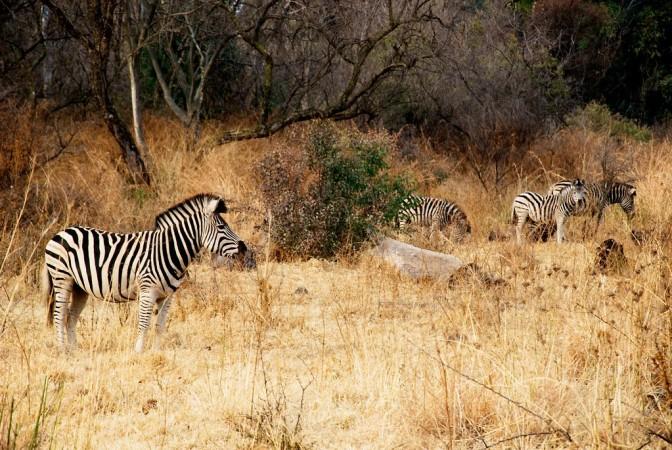
Explore the Groenkloof Nature Reserve - © Ryan Kilpatrick
Weather in Pretoria: Best Time to Visit
Spring in Pretoria
- Weather: Spring is characterized by gradually warming temperatures and blooming jacaranda trees. Daytime temperatures range from 15°C (59°F) to 25°C (77°F), with occasional light rains.
- Tourism Trend: Spring is a peak season for tourism in Pretoria due to the jacaranda blossoms. The city’s streets and parks are adorned with vibrant purple flowers, attracting visitors for walks, picnics, and outdoor events. The pleasant weather is perfect for exploring the city’s gardens, participating in local festivals, and enjoying outdoor cafes and markets.
Summer in Pretoria
- Weather: Summers in Pretoria are hot and generally dry, with temperatures ranging from 20°C (68°F) to 30°C (86°F). Thunderstorms are prevalent in the afternoons, bringing momentary relief from the hot weather.
- Tourism Trend: Summer is a popular time for outdoor activities and events, thanks to long daylight hours and warm temperatures. Visitors often explore the city’s parks and nature reserves, such as the Groenkloof Nature Reserve and the Pretoria National Botanical Garden. It’s also a great season for enjoying Pretoria’s vibrant street food scene and attending summer festivals.
Autumn in Pretoria
- Weather: Autumn brings cooler temperatures and less humidity. Daytime temperatures range between 15°C (59°F) and 25°C (77°F), making it an ideal time to explore the city.
- Tourism Trend: Autumn is ideal for sightseeing and cultural tours. With milder temperatures, visitors can comfortably explore historical sites like the Union Buildings and Freedom Park, or enjoy the city’s gardens and outdoor attractions. The season’s clear skies and pleasant weather make it a great time for photography and enjoying Pretoria’s scenic beauty.
Winter in Pretoria
- Weather: Winters in Pretoria are mild and dry, with temperatures ranging from 5°C (41°F) to 20°C (68°F). Mornings can be chilly, but daytime temperatures are pleasant.
- Tourism Trend: Winter is a great time for exploring Pretoria’s cultural and historical attractions without the heat of summer. Visitors often take advantage of the clear, sunny days to visit museums, art galleries, and historical landmarks. Winter is also a good season for wildlife viewing at nearby game reserves, where the cooler temperatures make for comfortable safari experiences.
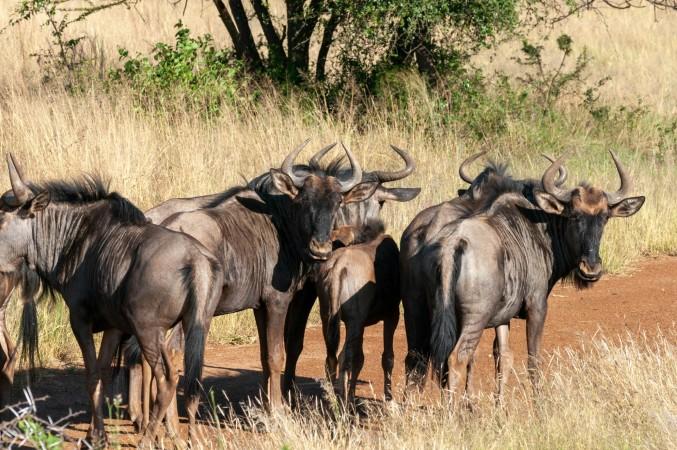
Take picture of the wildlife in Monateng Safari Lodge - © Steward Masweneng
Essential Travel Information
Getting Around Pretoria
- Buses: Pretoria’s public bus system, operated by Tshwane Bus Services, covers major routes throughout the city. Buses are a budget-friendly option for traveling, although schedules and routes might not be as frequent or convenient for tourists.
- Minibus Taxis: Minibus taxis are a popular and economical method to get around Pretoria. They run on established routes and are often used by locals for daily commutes. While they can be a cost-effective option, they may not always offer the most comfortable ride for tourists.
- Cycling: Pretoria has become increasingly bike-friendly, with several dedicated cycling paths and bike rental services available. Cycling is a great way to explore the city’s parks and scenic routes while enjoying the pleasant weather.
- Walking: Many of Pretoria’s attractions, including cultural sites and shopping areas, are best explored on foot. The city center and neighborhoods like Hatfield and Brooklyn are pedestrian-friendly, making walking a viable option for tourists looking to experience the city’s vibrant atmosphere up close.
ATM & Banking Services
Pretoria offers convenient banking and ATM services for visitors. Numerous banks are spread across the city, providing essential services such as currency exchange, account management, and financial advice. ATMs are widely accessible in commercial areas, shopping centers, and near key landmarks, allowing for easy cash withdrawals with international cards. Credit and debit cards are commonly accepted at most establishments, including hotels, restaurants, and shops, making transactions smooth and hassle-free.
Where to Stay in Pretoria
- Luxury Hotels: For those seeking a high-end experience, Pretoria offers several upscale hotels with luxurious rooms, comprehensive amenities, and central locations. These properties often feature fine dining options, spas, and premium services to enhance your stay.
- Mid-Range Hotels: There are numerous mid-range hotels that provide comfort and value for money. These establishments typically offer well-appointed rooms, on-site dining, and convenient amenities, making them ideal for both business and leisure travelers.
- Budget Hotels: Budget-conscious travelers will find a variety of guesthouses and affordable hotels that offer cozy accommodations at competitive rates. These options provide essential comforts and often feature a friendly, home-like atmosphere.
- Guesthouses: For a more personalized experience, Pretoria boasts numerous charming guesthouses and bed-and-breakfast establishments. These accommodations often offer a warm, homely environment with personalized service and a more intimate setting.
Des articles pour vous

Explore Yala National Park - Sri Lanka Travel, Asia
Tucked away in Sri Lanka’s southeastern corner, Yala National Park is where wild nature meets deep tradition. Known worldwide for its leopard population, the park is also home to elephants, sloth bears, crocodiles, and hundreds of bird species. Beyond wildlife, Yala opens doors to a cultural landscape dotted with ancient temples, Buddhist ruins, and coastal villages. For travelers seeking more than just a safari, Yala offers a chance to explore eco-tourism, local communities, and sacred heritage sites.
Population: The Yala National Park area doesn’t have a human population.
Economy: The economy around Yala National Park thrives on a blend of eco-tourism, agriculture, and local services. Safari tours, eco-lodges, and cultural experiences drive steady income for nearby towns like Tissamaharama and Kataragama, supporting thousands of families.
Landmarks: Famous for Block I of Yala and wildlife encounters, including elephants, sloth bears, crocodiles, and exotic bird species.

Explore Galle - Sri Lanka Travel, Asia
Nestled on Sri Lanka’s southern coastline, Galle is a vibrant city where history meets the sea. Its cobbled streets, colonial architecture, and serene beaches make it a must-visit destination for travelers seeking a blend of culture, adventure, and relaxation. A UNESCO World Heritage site, Galle captivates visitors with its Dutch Fort, bustling markets, and friendly locals. Whether you’re exploring the ramparts at sunset or savoring fresh seafood by the shore, Galle promises an unforgettable journey into Sri Lanka’s heritage.
Population: Approximately 113,000 in 2023.
Economy: Galle’s economy thrives on tourism, trade, and fisheries. The city’s historic fort, colonial architecture, and coastal charm draw thousands of international visitors each year, making tourism its main economic driver. Fishing remains vital for local livelihoods, supplying fresh seafood across the region.
Landmarks: Famous for the Galle Fort, Dutch Reformed Church & Maritime Museum, and Unawatuna Beach.

Explore Bentota - Sri Lanka Travel, Asia
Nestled along Sri Lanka’s southwestern coast, Bentota is a tropical paradise that blends golden beaches, vibrant culture, and thrilling adventures. Famous for its calm waters, luxury resorts, and scenic river estuary, Bentota has become a top destination for travelers seeking both relaxation and authentic experiences. From serene beach walks at sunrise to adrenaline-pumping water sports, this coastal town offers a perfect balance of leisure and exploration. With its proximity to Colombo and Galle, Bentota is easy to reach, making it an ideal stop for both short escapes and extended holidays.
Population: Approximately 37,000 in 2023.
Economy: Bentota’s economy thrives mainly on tourism, which drives local businesses such as hotels, restaurants, and wellness retreats. The town also benefits from fishing, coconut cultivation, and handicrafts like wood carving and batik textiles. Many residents rely on the growing demand for water sports and Ayurvedic treatments, making tourism the backbone of both income and employment in the area.
Landmarks: Famous for Bentota Beach, Bentota River Safari, and Kande Vihara Temple.

Explore Mirissa - Sri Lanka Travel, Asia
Mirissa is a charming coastal town on Sri Lanka’s southern shoreline. Known for its golden beaches, turquoise waters, and vibrant marine life, it has become a must-visit stop for travelers exploring the island. Many come for whale watching, surfing, and sunset views at Coconut Tree Hill, but Mirissa offers much more than postcard beauty. The fishing boats you see anchored by the bay carry generations of stories. Local traditions, delicious cuisine, and a laid-back rhythm of life shape every visitor’s experience.
Population: Approximately 4,700 in 2023.
Economy: Mirissa’s economy is largely shaped by its coastal location. Fishing has long been the backbone of local livelihoods, with generations relying on the Indian Ocean for income. In recent decades, tourism has become the main driver of growth, thanks to whale watching, surfing, and beachside hospitality.
Landmarks: Famous for Mirissa Beach, Coconut Tree Hill, and Parrot Rock Bridge.

Explore Nuwara Eliya - Sri Lanka Travel, Asia
Tucked away in the Central Highlands of Sri Lanka, Nuwara Eliya is often called “Little England”. With its rolling tea plantations, cool misty mornings, and colonial charm, this mountain town feels like a step into another world. Travelers come here to breathe fresh air, walk through flower gardens, sip the finest Ceylon Tea, and enjoy a pace of life far from the island’s busy cities. Whether you’re drawn by scenic landscapes, heritage architecture, or the warmth of its people, Nuwara Eliya is a destination that blends nature, culture, and history in perfect harmony.
Population: Approximately 781,000 in 2023.
Economy: Nuwara Eliya’s economy thrives mainly on tea production, as it sits in the heart of Sri Lanka’s central highlands, famous worldwide for Ceylon Tea. The city also benefits from a growing tourism industry, attracting visitors with its colonial charm, cool climate, and scenic landscapes.
Landmarks: Famous for Gregory Lake, Hakgala Botanical Garden, and Victoria Park.

Explore Sukau - Malaysia Travel, Asia
Nestled on the banks of the Kinabatangan River in Sabah, Malaysian Borneo, Sukau is a destination where wildlife, culture, and conservation come together. Known as one of Asia’s top spots for river safaris and eco-tourism, this quiet village offers a front-row seat to encounters with Bornean orangutans, pygmy elephants, proboscis monkeys, and exotic birdlife.
Population: Approximately 1,400 in 2019.
Economy: Sukau’s economy is shaped by its riverine location and natural resources. Traditionally, the Orang Sungai community relied on fishing, small-scale farming, and forest gathering for their livelihood. Today, the village has shifted toward eco-tourism, with river cruises, jungle trekking, and homestays providing income.
Landmarks: Famous for the Kinabatangan River cruises, Gomantong Caves, and Ox-bow lakes and wetlands.
